The Statue of Liberty, also known as "Liberty Enlightening the World," is located on a small island between the beautiful New York Harbor and the shores of New Jersey, stands as a powerful symbol of freedom, equality, and hope.
Crafted from copper and installed on Gustave Eiffel’s designed iron frame, A gift from the people of France to the people of America in 1886, this is a world-famous monument that continues to inspire millions of people around the world.

Throughout history, the rights to freedom and equality were often held by only a few, while many remained oppressed. As civilizations evolved, revolutions around the world were sparked by the struggle for liberty and human rights. In this context, the Statue of Liberty stands not just as a monument but as a lasting symbol of those ideals. In the United States, it also represents a historic bond of friendship between the people of two nations—France and America—who share a common dream of freedom and justice.
Let’s uncover the secrets and stories behind America’s greatest symbol of freedom—the untold history of the Statue of Liberty.
Table of content
- How it is Started?
- Engineering Marvel Behind the Statue of Liberty’s Construction
- From 1886 to Today: What Has Happened
- Visit the Statue of Liberty, Distance, Timing, Ticket Price
- Some Hidden Fact
1. How it is Started?
The Statue of Liberty is a very special monument. It was constructed in France, funded by donations from ordinary people of france. other side its pedestal are build by donation of the common American people. When the statue arrived in America, the arrival of the ship was greeted enthusiastically by the people of America. can you imagine the excitement and joy of that moment at that time.
Journey Begin with idea of Édouard René de Laboulaye
Until 1870, France was ruled by the Second French Empire. Meanwhile, America, having gained independence in 1776, had already established itself as a democracy. After the American Civil War, President Abraham Lincoln abolished slavery, making the country a center of freedom, equality, and human rights for people around the world.
One such value a great admirer was Édouard René de Laboulaye, a political thinker, anti-salvery, and strong supporter of democracy from France. He came up with the idea that France should gift a monument to the United States in honor of the centennial celebration of its independence.
Laboulaye first discussed this idea at a dinner in Paris.
Frédéric Auguste Bartholdi: From Dream to Design
importantA year later, Laboulaye met Frédéric Auguste Bartholdi, a talented French sculptor. Bartholdi was deeply inspired by the idea and began working on the project that same year.
In 1871, Bartholdi visited the United States and presented the idea. He selected Bedloe’s Island (now known as Liberty Island) near New York Harbor as the location for the statue.
During this period, Napoleon III, the ruler of France, lost the Franco-Prussian War to Germany. The Third Republic was established, and hopes for democracy among the French people were renewed.
But Bartholdi now faced a huge challenge—there was no funding for such a grand project.
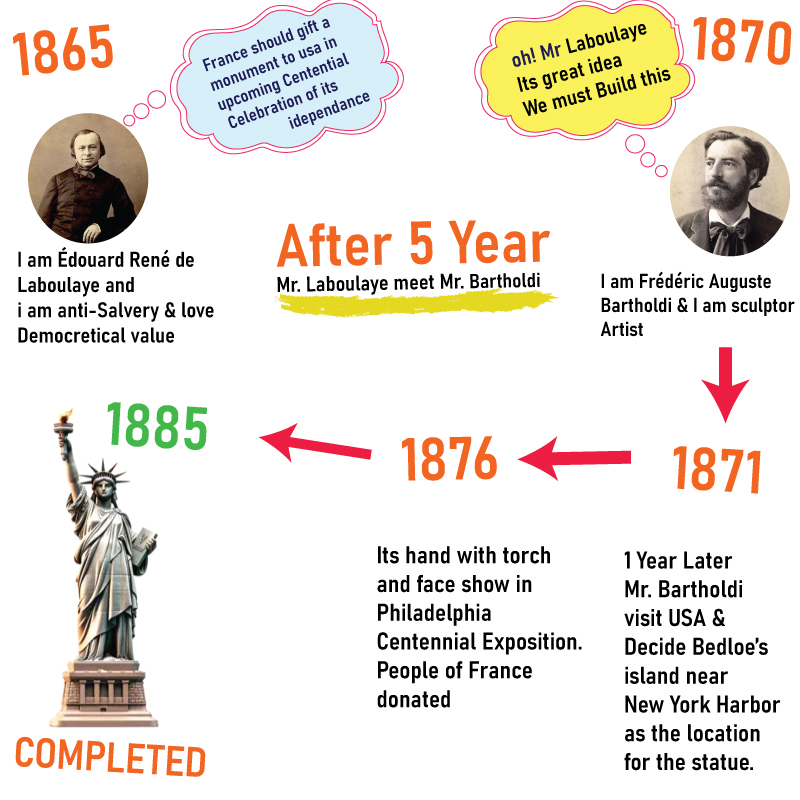
A Statue by the People, for the People
Laboulaye and Bartholdi decided that the project would be funded entirely by the French public. They made an official announcement, and in 1876, the statue’s right arm holding the torch was displayed at the Philadelphia Centennial Exposition. The goal was to build confidence and raise money, assuring people:
"We are truly doing this. We just need your support."
The Statue of Liberty was funded by the French public through donations, lotteries, public events, art exhibitions, and widespread support from schoolchildren, workers, and everyday citizens. A total $ 250,000 was donated by the people of France.
Between 1881 and 1884, the construction of the statue was completed in France. In 1884, it was formally shown to the U.S. ambassador in Paris.
important The statue stood 151 feet 1 inch tall, so it could not be transported in one piece. so it is designed into 350 parts, in such that it can be disassembled and reassembled.
The Journey to America
In 1885, the 350 pieces were packed into wooden crates and shipped to America aboard a French navy vessel named Isère.
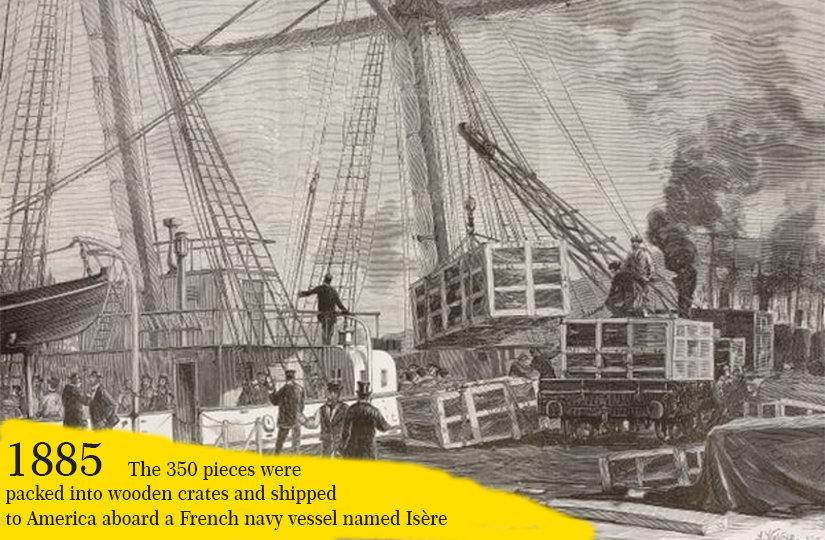
To install the statue, a massive pedestal had to be built in the U.S., and work began in 1881. But once again, funding became a problem. Many Americans were suspicious about it . Some saw it as a scam. Even wealthy industrialists ignored it.
important Then, Joseph Pulitzer, the powerful newspaper publisher, came to the rescue. In his paper The World, he criticized the wealthy and called on ordinary people to donate. He promised that every donor’s name and contribution would be published, no matter how small.
This appeal worked—$100,000 was raised in a short time. By 1886, the granite stone-made pedestal was completed.
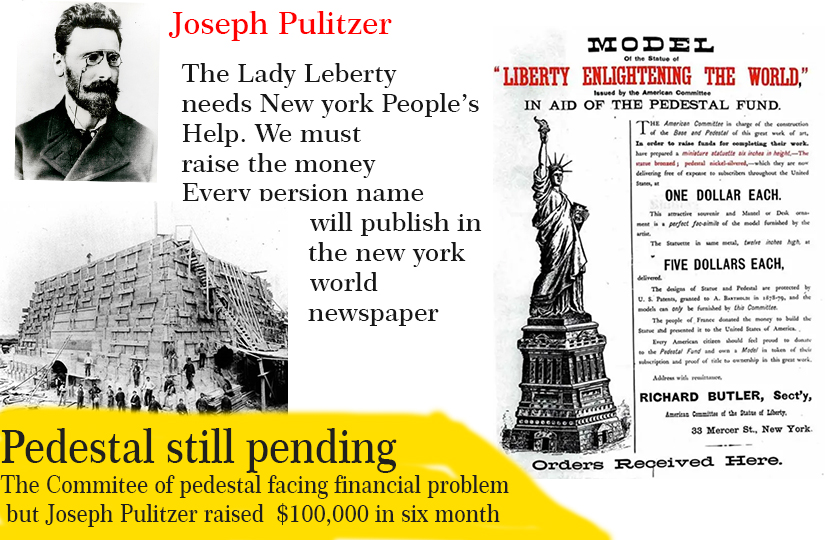
The Grand Unveiling
On October 28, 1886, the Statue of Liberty, draped in the French tricolor, was unveiled. Crowds gathered, and Mr. Bartholdi stood inside the face of the statue looking from the crown to witness his dream come true.
important USA President Grover Cleveland officially inaugurated the statue, and over one million people celebrated its arrival.
Since then, for more than 136 years, the Statue of Liberty has stood tall in the ocean.
A Beacon Through Time
America has suffer two world wars, economic depressions, the Cold War, the Vietnam War, and COVID-19 pandemic —yet it has emerged stronger each time. During this critical time,the Statue of Liberty continues to stand as a shining beacon of hope for all who believe in freedom, equality, dignity, and human rights.

2. Engineering Marvel Behind the Statue of Liberty’s Construction
Over the past 136 years, the Statue of Liberty has withstood countless storms, wars, and extreme weather conditions—yet it still stands tall and proud. Behind this resilience lies the brilliant engineering of Frédéric Auguste Bartholdi and Gustave Eiffel.
As we’ve already learned, the statue was built in two parts:
- The pedestal, constructed in America
- The statue, crafted in France
Repoussé Technique: Sculpting with Precision
The statue was made by crafting 305 individual copper sheets, each roughly as thick as two coins. These copper plates were hammered and shaped using wooden molds and hand tools. The process used is known as repoussé
important repoussé is a challenging technique where metal is not melted, but instead shaped by hammering from the reverse side. This method makes it difficult to sculpt a figure exactly as desired, requiring both precision and artistry.
The Iron Framework: Eiffel’s Genius at Work
While Bartholdi designed the outer sculpture, the bigger challenge was to create an internal iron framework, or armature, that could withstand harsh weather and strong winds. This is where Gustave Eiffel’s magical engineering came into play—the same Eiffel who later designed the famous Eiffel Tower in 1887.
Flexible Iron Frame Design
Eiffel created a flexible iron skeleton. The core of the structure is a main steel rod, with a secondary iron bar connected in such a way that the statue can slightly sway in strong winds. This flexibility helps prevent damage and ensures long-term durability.
Protection from Copper-Iron Reaction (Corrosion)
Since the statue’s skin is copper and the internal structure is made of iron, they could chemically react and corrode over time. To prevent this, engineers used asbestos-based insulation between the copper plates and iron frame to block any chemical reactions and moisture damage.
Independent Copper Cladding
Each copper plate is not directly attached to the iron frame. Instead, every plate is mounted on a secondary support saddle, which allows the “skin” and “skeleton” of the statue to expand and contract independently with temperature changes—another example of smart, future-proof design.
This combination of artistic vision and engineering brilliance has allowed the Statue of Liberty to withstand the test of time. Thanks to the innovations of Bartholdi and Eiffel, Lady Liberty remains a shining symbol of freedom and strength to this day
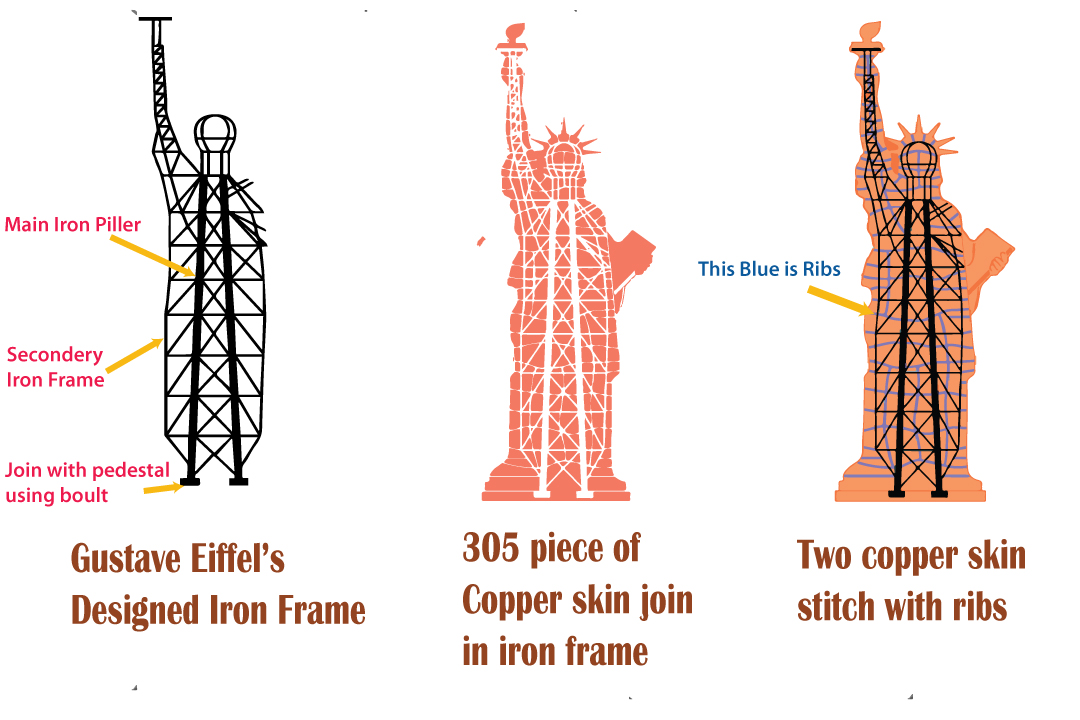
3. From 1886 to Today: What Has Happened :
Over the past 136 years, the Statue of Liberty has witnessed countless challenges. The world has changed dramatically—two World Wars, economic depressions, and even a global pandemic like COVID-19. From the age of steam engines to the rise of artificial intelligence, humanity has evolved, and through it all, the Statue stands firmly in the same place, silently connecting the threads of history and progress.
1916 -Black Tom Explosion
German saboteurs blew up munitions near Liberty Island.
Public access to the torch has been closed since then due to damage from the blast.
1924 – Declared a National Monument
The Statue of Liberty was officially declared a U.S. National Monument, increasing its historical and cultural importance.
1956 – Renamed Liberty Island
The island was originally called Bedloe’s Island, but in 1956, it was officially renamed Liberty Island.
1984–1986 – Major Restoration Project
Leading up to the 100th anniversary, the statue underwent a complete renovation. The copper structure and torch were restored. A new gold-leaf torch was added.
1984 – Declared a UNESCO World Heritage Site
The statue was recognized globally as a World Heritage Site by UNESCO for its universal symbolic value.
2001 – Post 9/11 Security
After the September 11 attacks, the statue was temporarily closed. Over time, different parts reopened with enhanced security protocols.
2009–2019 – The crown and interior reopened
The crown and interior sections were gradually reopened to the public. Strict reservation systems were implemented for safety.
2020 – COVID-19 Closure
During the COVID-19 pandemic, the Statue of Liberty and museum were closed for a time.
4. Some Hidden Fact
1. The Statue Moves in the Wind
Lady Liberty may look still, but in strong winds, she sways up to 3 inches, and the torch moves up to 5 inches! This flexibility comes from Gustave Eiffel’s brilliant internal iron framework.
2. Full Name Isn’t Just “Statue of Liberty”
The statue’s official name is “Liberty Enlightening the World.” It was a gift from France to celebrate American independence and the shared values of freedom.
3. Broken chains near her feet which can not be seen from the ground
Liberty's right foot is mid-stride, symbolizing moving forward and breaking free from oppression and slavery. There are also broken chains near her feet, often missed by tourists.
4. The Torch Today Is Not the Original
The original torch was replaced in 1986 during the statue's 100th anniversary. The new torch is made of 24k gold-leaf, and the original is now displayed inside the pedestal museum.
5. She Was Originally a Reddish-Brown Color but turned blueish-green after 30 years
When installed, the statue was the color of new copper (like a penny). Over the years, exposure to air and water. The natural oxidation process happened. Over about 30 years, it turned green (patina). this is work as a natural protective layer.
6. Taller Than You Think
Statue length is 151 feet (46 m) and with pedestal and base, 305 feet (93 m), which is taller than a 22-story building!
8. Her Crown Has 7 Spikes
The crown’s seven spikes represent the seven continents and seven seas, symbolizing liberty spreading throughout the world.
9. Funded by People, Not Governments
Both France and America relied on public donations to build the statue and pedestal. Even school children gave coins to help finish it.
10. There are 354 Steps to the Crown
A tight, bi-directional spiral staircase has been designed in such a way that one can climb up from one side and go down from the other
Visitors can climb 354 narrow steps (22 stories) to reach the crown. here you can see an unforgettable view of New York Harbor
5. Visit the Statue of Liberty, Distance, Timing, Ticket Price
How to Reach
Liberty Island is located between New Jersey and Manhattan. Ferries operate from Liberty State Park in New Jersey and Battery Park in Manhattan.
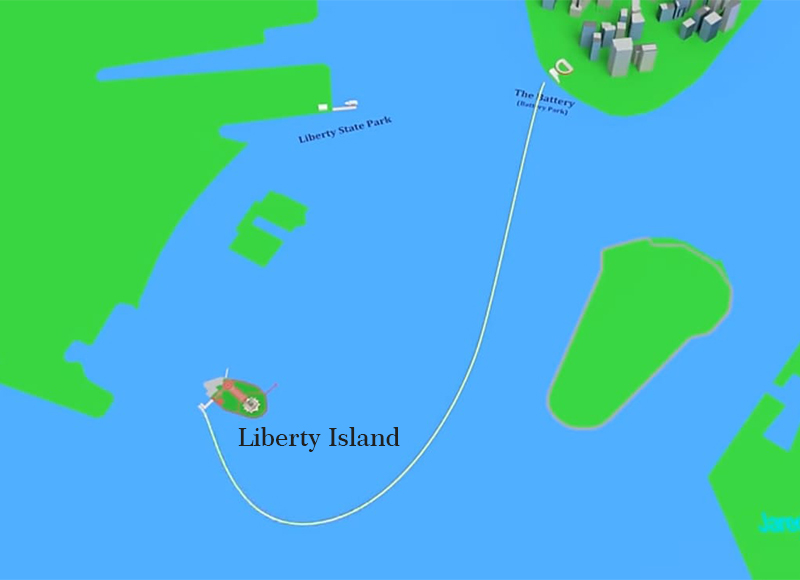
If you're coming from Times Square, Battery Park is about 6 kilometers away. By taxi, you can reach Battery Park in around 20 minutes. From there, it takes another 15 to 20 minutes to reach Liberty Island by the ferry.
Once you arrive at the island, you can reach the pedestal via the walkway. On the other side of the path is a museum where the original torch is displayed.
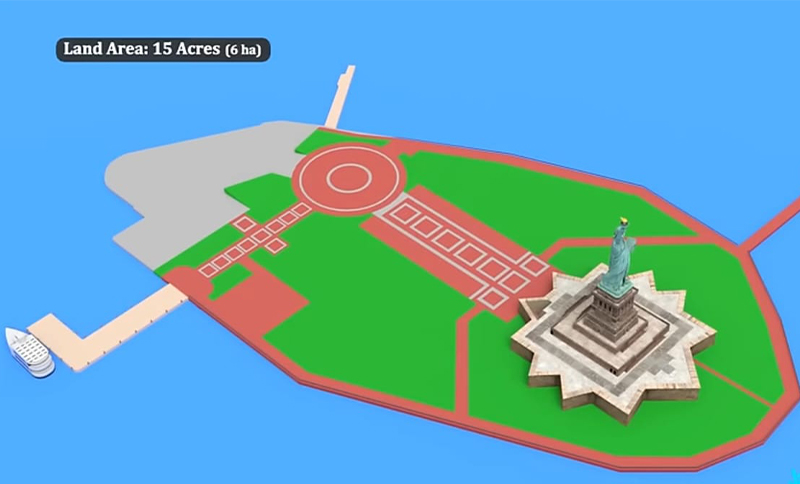
To enter the pedestal, there is a door called the Centennial Door.
The pedestal has a total of seven stories, which can be accessed via stairs or an elevator. From the top of the pedestal, you get a spectacular view of New York Harbor. Truly, it can be a unique and unforgettable experience.
To go further up to the crown, there are helical (spiral) stairs, which are quite steep. Only a limited number of visitors are allowed to access the crown.
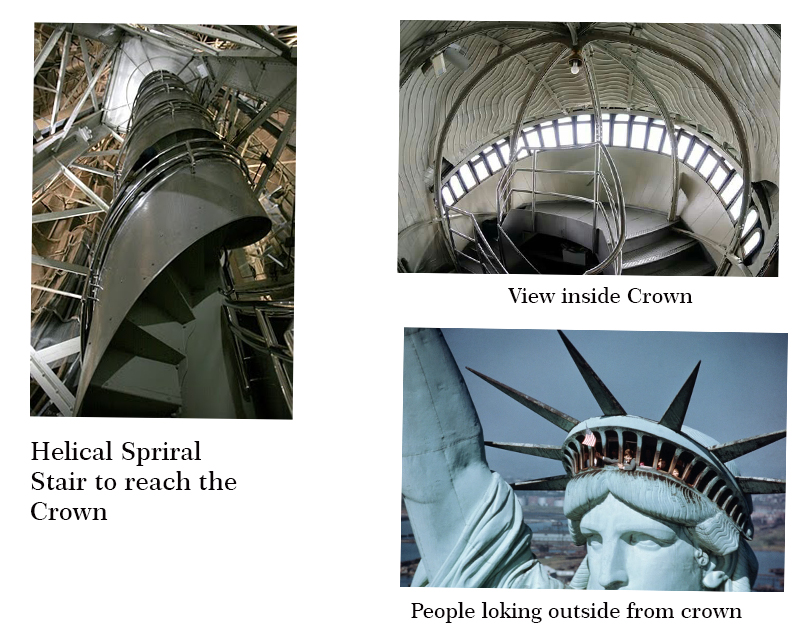
When you climb 111 feet using these stairs, you will to see the stunning city of New York from a height of 305 feet above from the Atlantic Ocean—this could very well be the most special moment of your life.
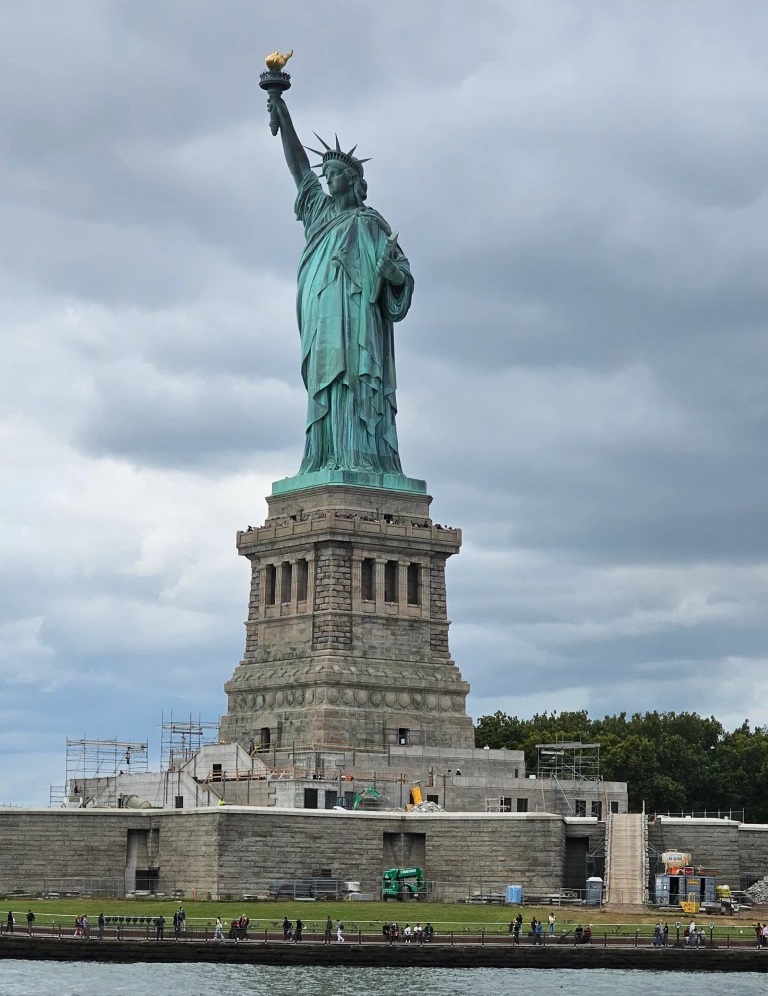
Timings
The first ferry from the mainland to the island departs at 8:30 AM, and the last ferry leaves at 4:00 PM.
The island remains open till 5:00 to 5:30 PM. The island is closed on Christmas and Thanksgiving Day.
Ticket Prices
ticket is booking online
- Adults (13–61 yrs): $24.50
- Seniors (62+ yrs): $18.00
- Children (4–12 yrs): $12.00
- Infants (under 4 yrs): Free
- Crown reservation system: $3 to $5
General ticket prices include round-trip ferry service to both Liberty Island and Ellis Island.
This ticket allows access to the pedestal of the Statue of Liberty.
To go to the crown, you need a strict reservation system, and tickets must be booked in advance due to limited availability per day. The ticket price for crown access is $3 to $5.
Travel Tips
Arrive early morning to avoid long lines
Wear comfortable shoes—there’s a lot to walk and climb!
Don’t forget your ID (especially for crown or pedestal access)
Weekdays are less crowded than weekends
